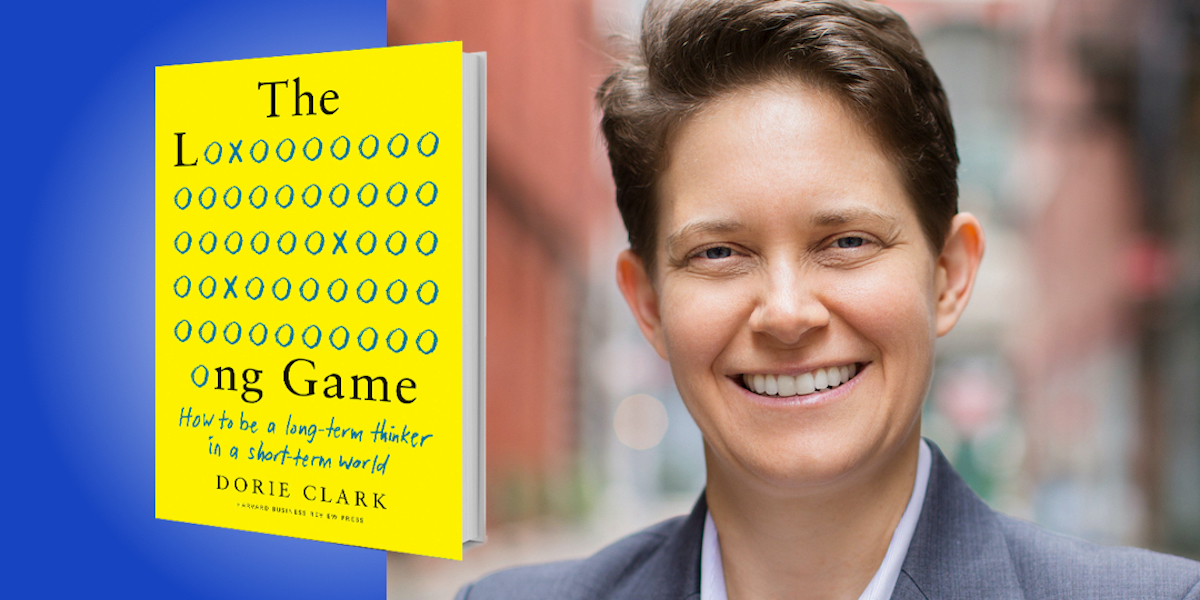Dorie Clark is a consultant and keynote speaker who teaches executive education at Duke University’s Fuqua School of Business and Columbia University’s Graduate School of Business. She is the author of Entrepreneurial You, Reinventing You, and Stand Out. The New York Times has described Clark as an “expert at self-reinvention and helping others make changes in their lives.”
Below, Dorie shares 5 key insights from her new book, The Long Game: How to Be a Long-Term Thinker in a Short-Term World. Listen to the audio version—read by Dorie herself—in the Next Big Idea App.
1. Decide what to be bad at.
Frances Frei, a professor at Harvard Business School, and Anne Morriss, an entrepreneur, wrote a book called Uncommon Service about service industry businesses. They were trying to figure out why so many businesses—airlines, banks, etcetera—were just mediocre, and so few were awesome. And what they discovered is this: “Choosing to be bad is your only shot at achieving greatness. And resisting it is a recipe for mediocrity.” Mic drop.
I realized that that applies in our own lives, too. We think we can excel at a few things and be fine at everything else. Nope—we have to commit to the essence of strategy, which is saying, “I’m going to drop this ball completely so I can be amazing somewhere else.” There are hard choices we have to make: Don’t launch that initiative! Shut that other one down! Take three weeks to answer your email! But those hard choices are worth it if they allow you to completely outstrip the competition elsewhere.
“Choosing to be bad is your only shot at achieving greatness. And resisting it is a recipe for mediocrity.”
2. Adopt 20% time.
You may have heard about the “20% time” concept from Google, which made it famous. The idea is that employees get to spend up to a fifth of their time on speculative projects that don’t relate to their day jobs—just things that employees are interested in that they think will help benefit the company. Still, it is challenging to carve out 20% time; one survey revealed that even at Google, only 10% of employees do it.
So yes, it takes extra effort to protect your 20% time, but I believe we should all be doing it. Because if COVID showed us nothing else, it’s that we can’t predict what’s coming down the pike. And the best way to protect ourselves from uncertainty is to work to develop skills and knowledge and connections that we didn’t even know we needed. That way, we’re ready for anything.
For me, I’ve spent the past five years assiduously training to become a musical theater lyricist. Why? Eh, why not? It’s helped me build a huge network of people I wouldn’t have connected with otherwise, I’ve expanded myself, it’s fun, and it’s opened up new opportunities down the line I can’t even predict. Maybe for you, the 20% time is spent on networking and building connections with new people, or taking online classes, or reading books, or working on a special project or initiative. That 20% time is a critical investment in the person you’re going to become.
“The best way to protect ourselves from uncertainty is to work to develop skills and knowledge and connections that we didn’t even know we needed.”
3. Embrace “Heads Up” and “Heads Down” modes.
Long-term thinking is great, but the key to getting anything done, of course, is taking action on it. So we all need to get better at toggling between two modes: There’s Heads Up mode, when we’re taking in ideas and insights, we’re meeting people, making connections, and figuring out what we’re going to do. And then there’s Heads Down mode, when you focus and execute. This is a crucial part because without it, everything just stays a good idea, and it never actually happens. By understanding the right time to look for new ideas in Heads Up mode, and to make progress on them in Heads Down mode, we actually do what needs to get done. We’re not quitting too soon by constantly snapping back into Heads Up mode, and we’re not persisting too long on a bad idea by never leaving Heads Down mode.
For all of us, it’s worth thinking about whether we already have a good balance of Heads Up and Heads Down, or if we have a propensity to lean too far in one direction—and if we do, being cognizant can help us correct it.
4. No asks for a year.
A key part of playing the long game is building long-term relationships, and the fastest way to blow that up is to ask a new contact for a favor too soon. So I created the “no asks for a year” rule. Of course, that doesn’t mean asking them to do something with you, which is the point of friendship, or asking them a question, like where they got their sweater. But especially if you’re cultivating a relationship with a high-status person, be aware that a lot of people want things from them—and you do not want to be one of those people, because you’re going to look like a user.
“A key part of playing the long game is building long-term relationships, and the fastest way to blow that up is to ask a new contact for a favor too soon.”
I learned this the hard way years ago. I met this woman at a conference, and we’d struck up a nice friendship via email. Then I saw a video of her speaking to an organization that I wanted to break into, so I sent her a note asking for advice on how to do that. Mind you, I wasn’t asking for an introduction, just advice. But I never heard back from her. I soon realized that she didn’t know me well enough to know the difference between me and the people who would have pounced and said, “Can you introduce me now?!”
So I learned to stay away from all of that. To keep them from inferring that you have an agenda, and frankly to keep yourself from even subconsciously constructing one, the “no asks for a year” rule keeps you honest. You’re only focused on building your connection with that person. And once you’re friends, it’s easy to ask for favors because you genuinely care for each other, and no one’s keeping score.
5. Understand the deception phase.
Achieving long-term goals almost always takes way longer than we want. And for long, sometimes dispiriting periods, we don’t see very much progress at all—sometimes none! That’s why a lot of smart and talented people give up, but I believe many of them give up too soon.
A concept that gives me a lot of comfort comes from Peter Diamandis and Steven Kotler, who write about something they call the “deception phase” of exponential technology—things like 3D printing or artificial intelligence that improve exponentially over time. For a long time, people look at the progress being made, and they’re totally unimpressed. But all along, progress is doubling—it’s just so small at first that it can’t be perceived unless you look very closely. Then at a certain point, it becomes visible to the naked eye and—wow! They wonder where it came from, because it overtook everything so fast.
If you’re in the thick of the deception phase right now, it can feel lonely and frustrating, like nothing is going right. But remembering that others have been there—including people who have developed groundbreaking technology—can help us get through it. So keep in mind that progress is happening; it’s just not visible to the outside world yet.
To listen to the audio version read by Dorie Clark, download the Next Big Idea App today:
































